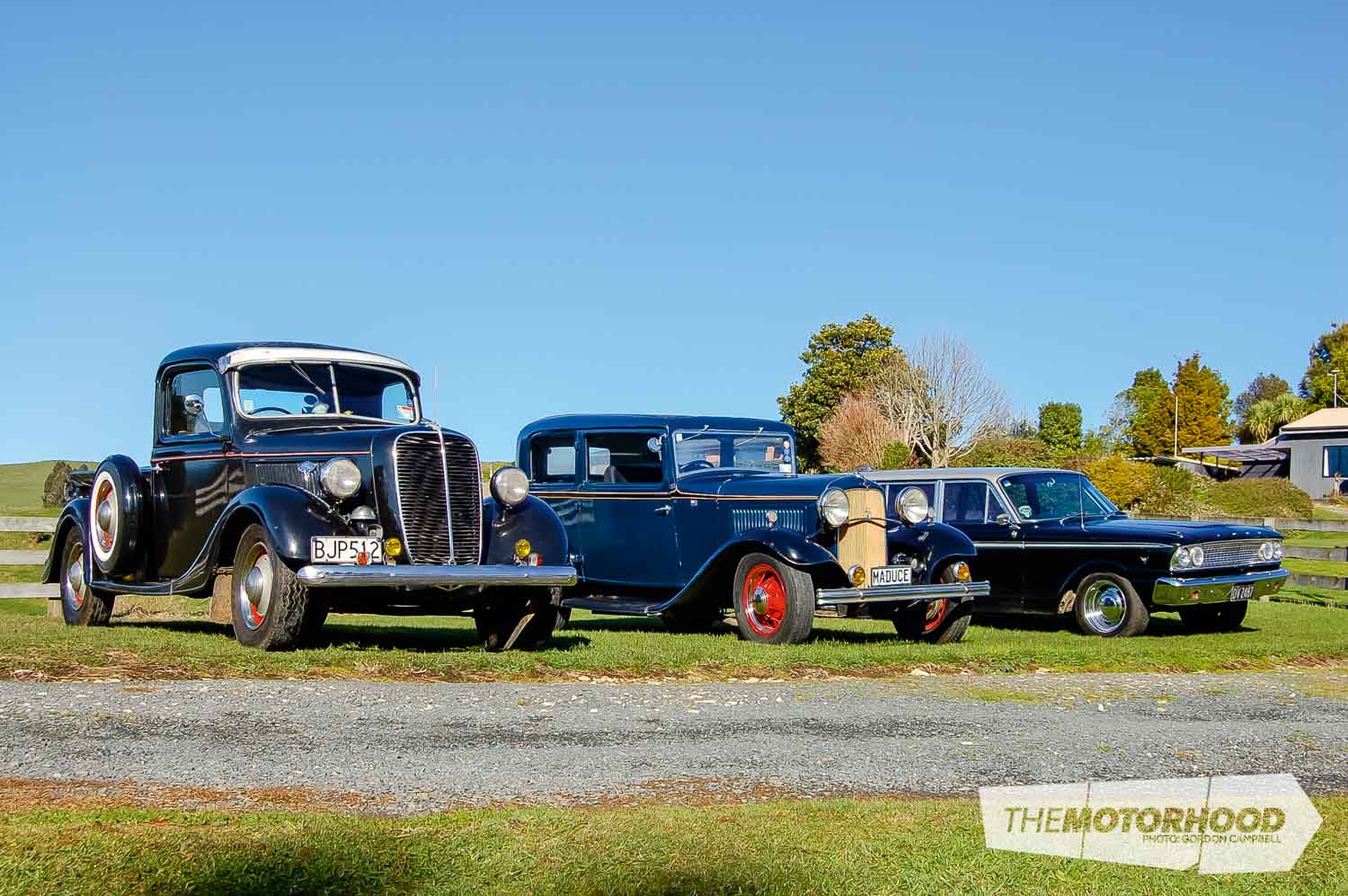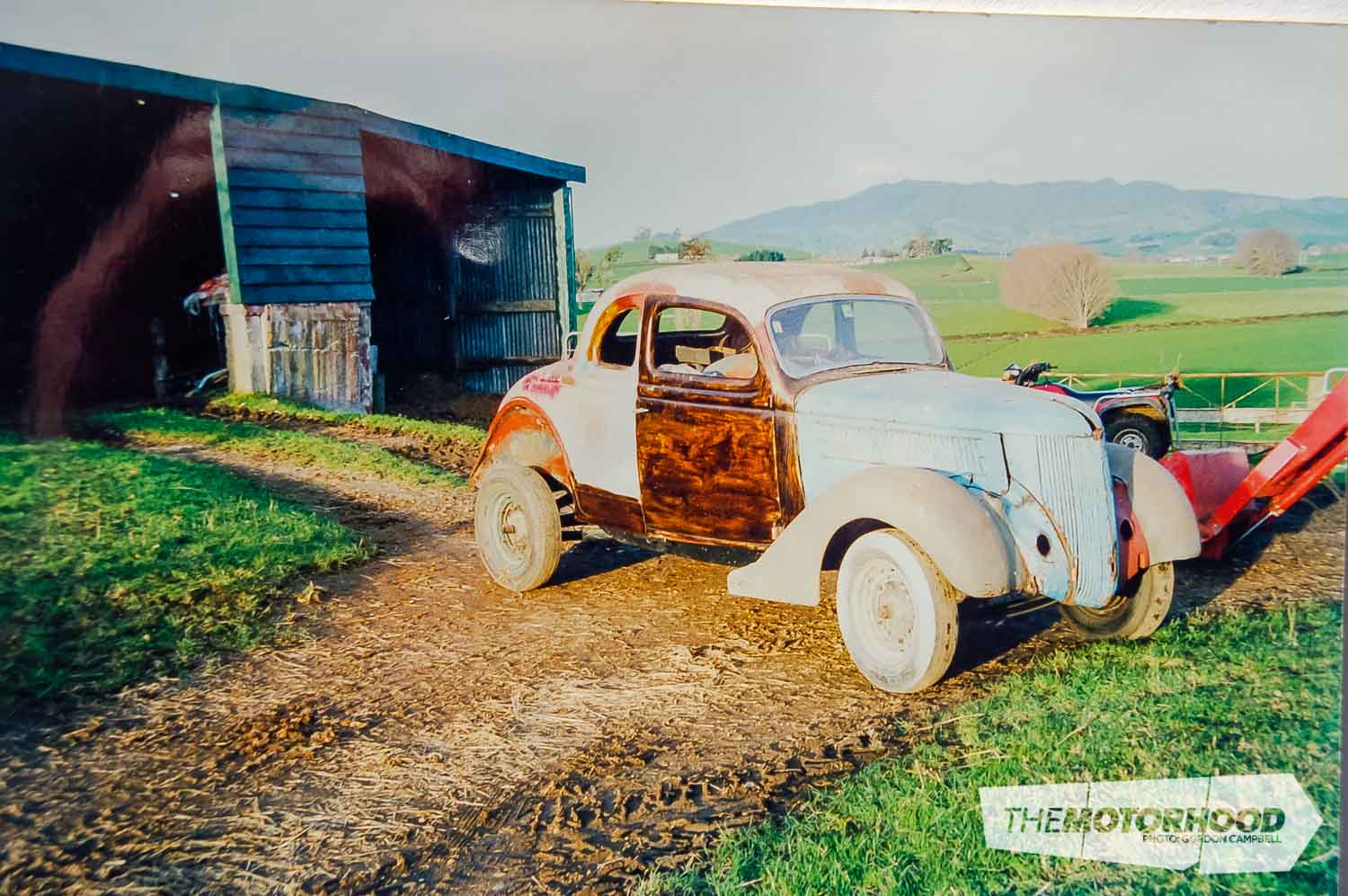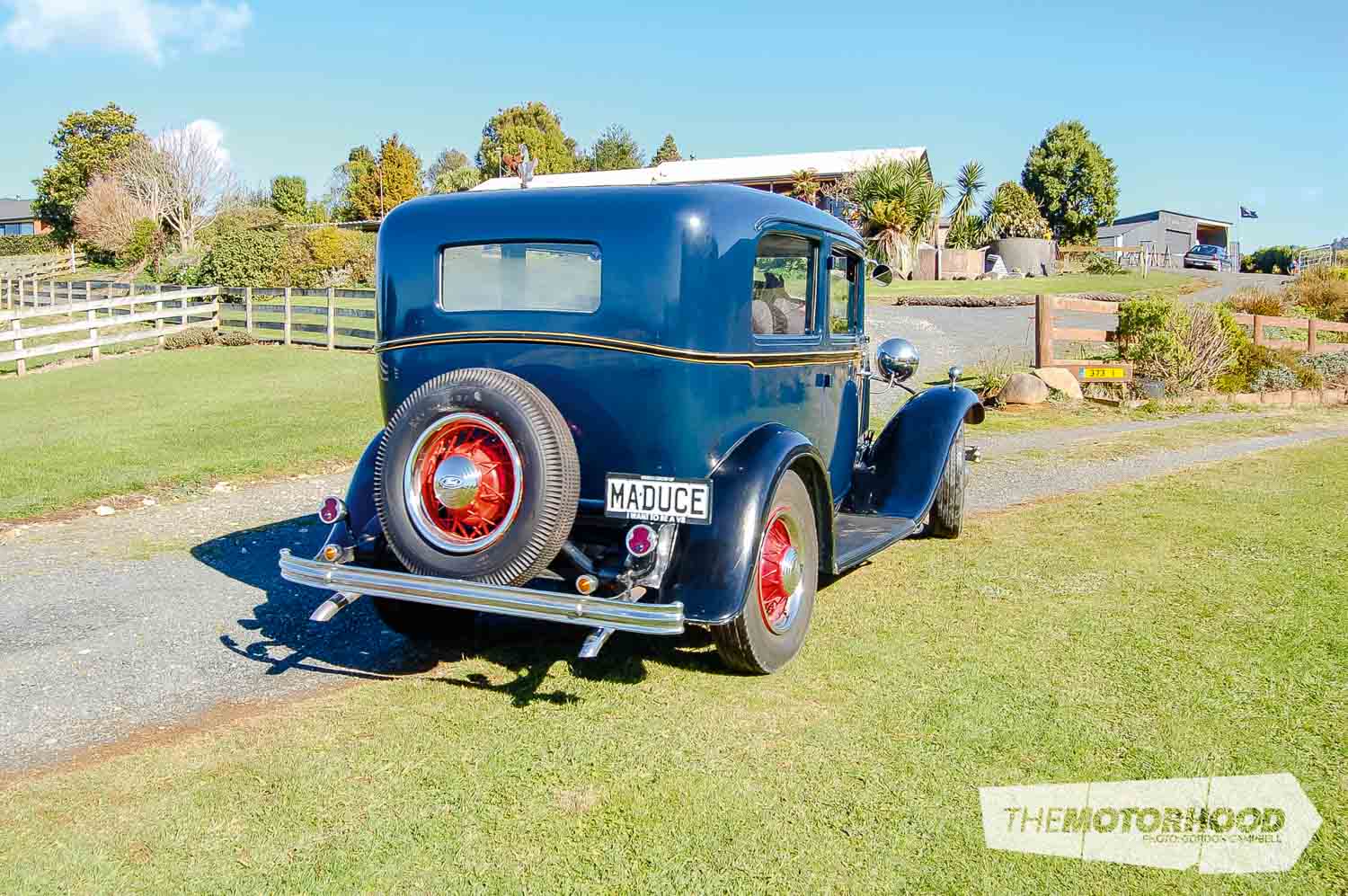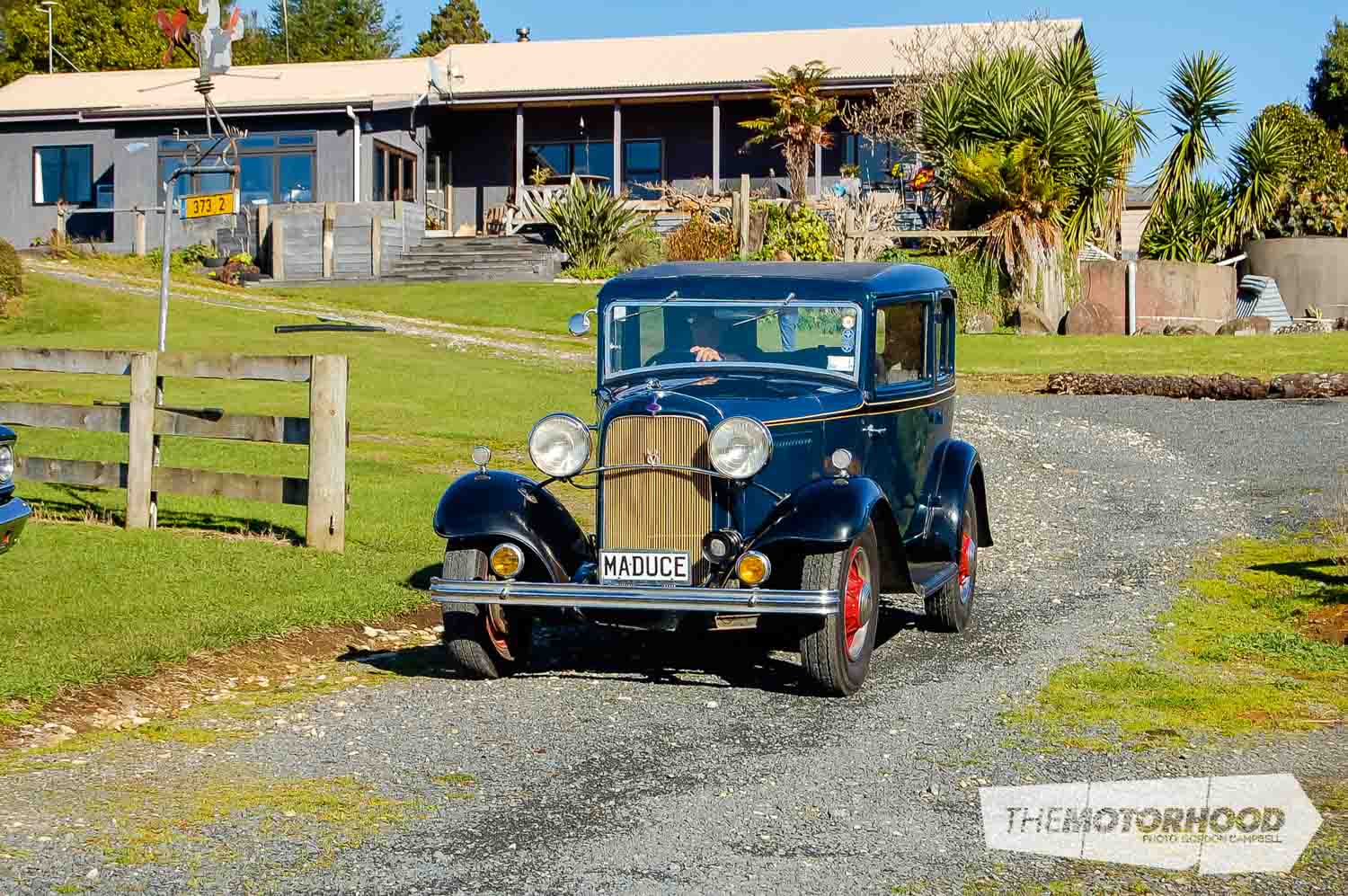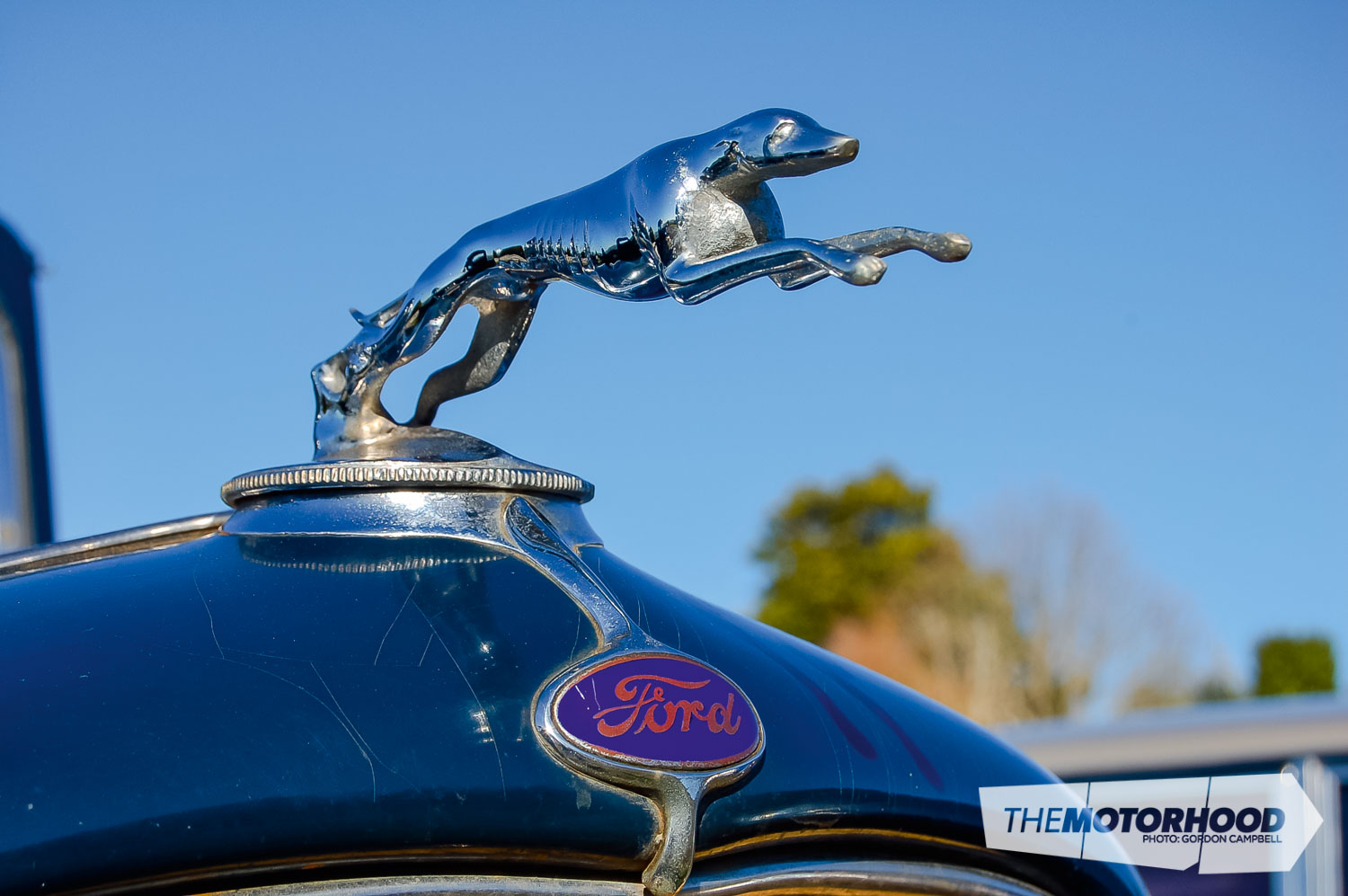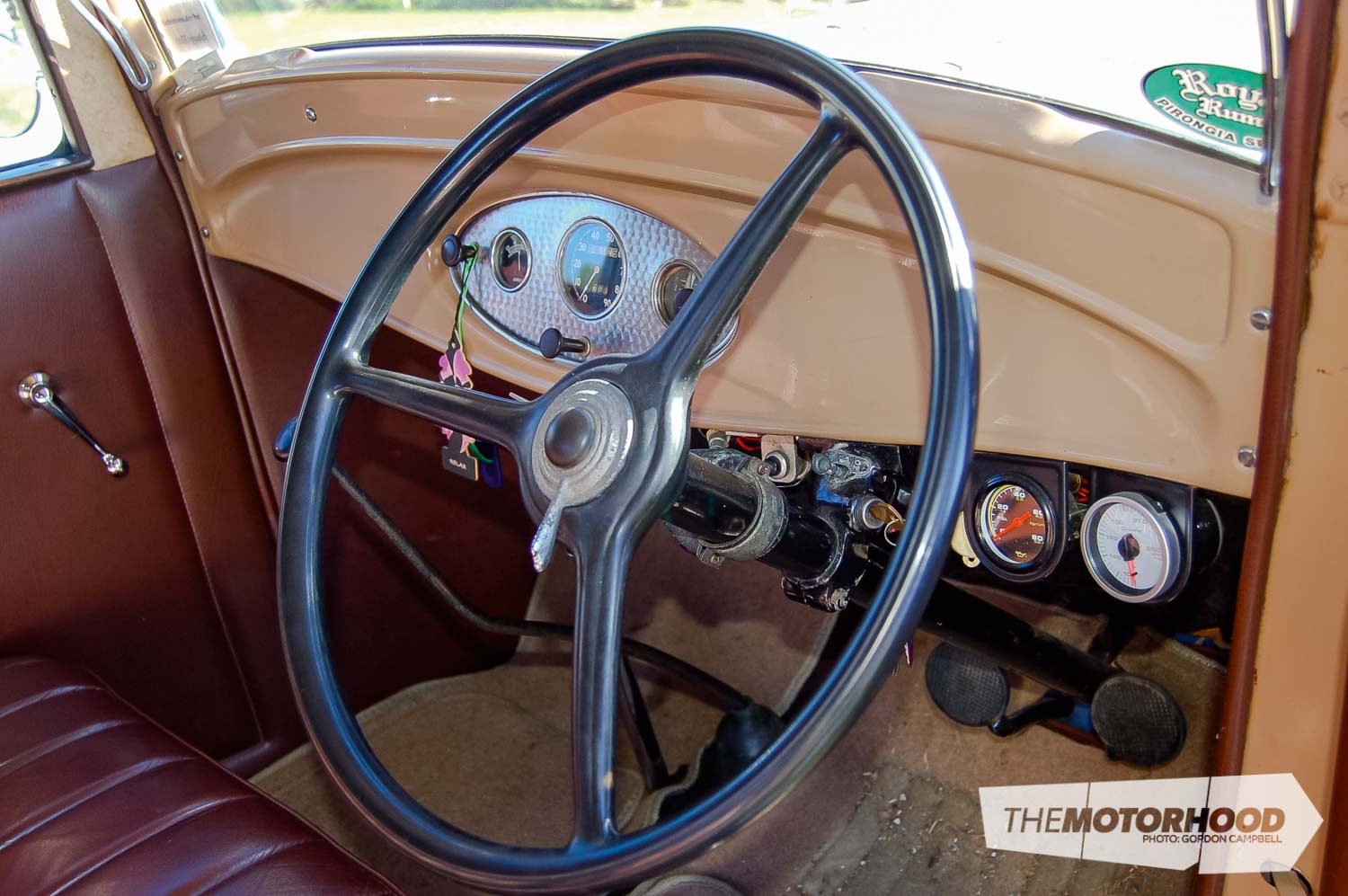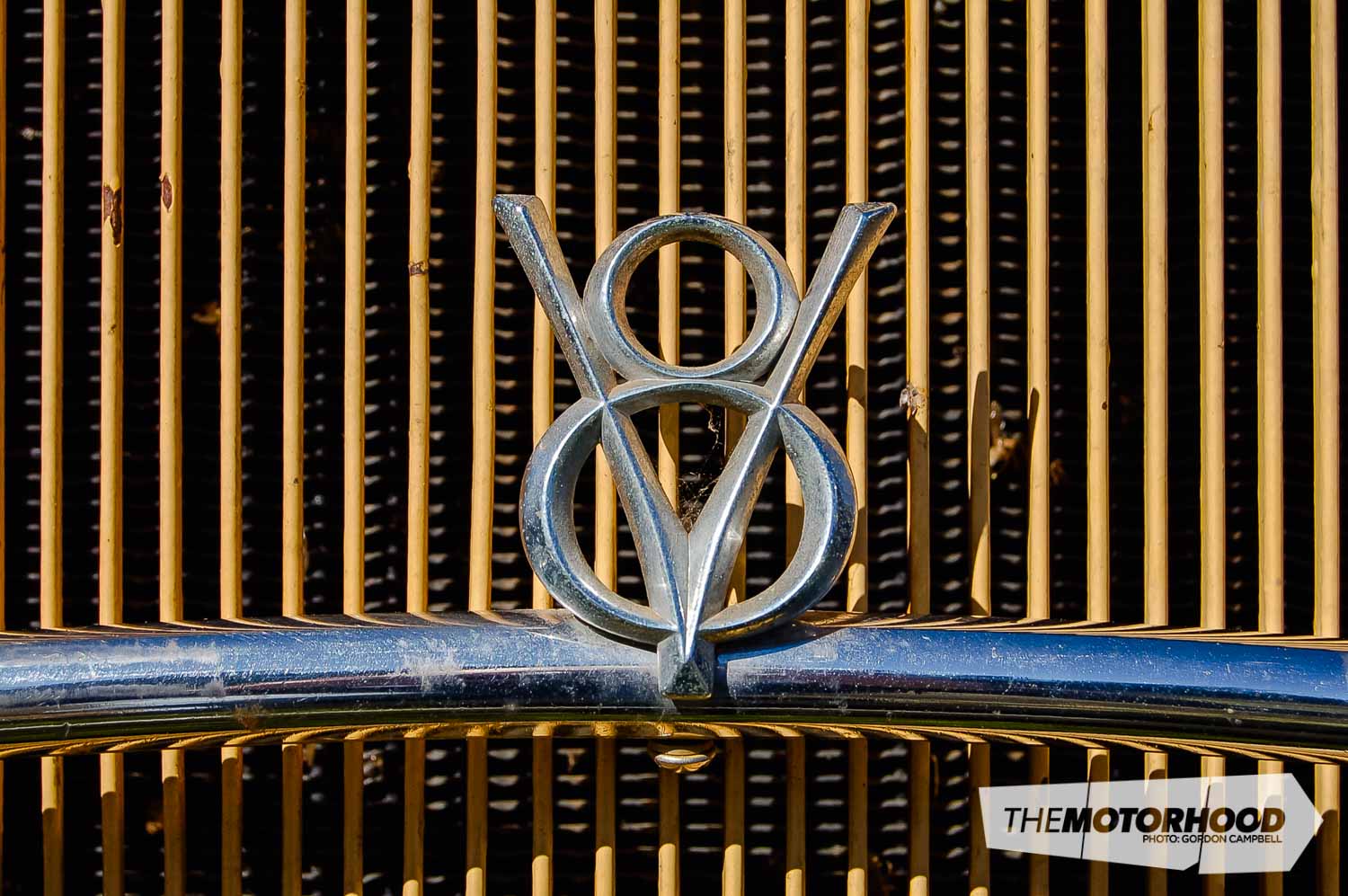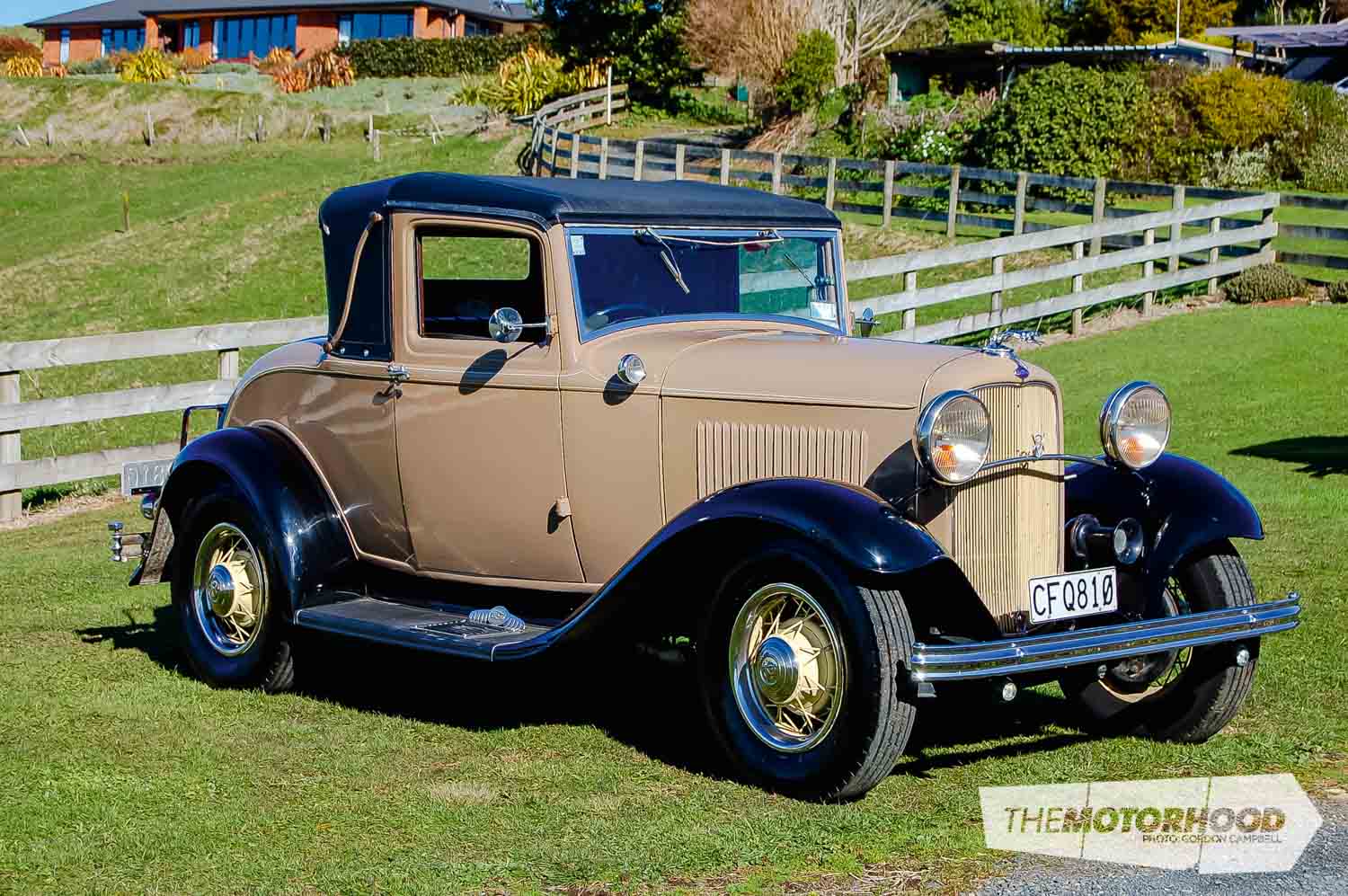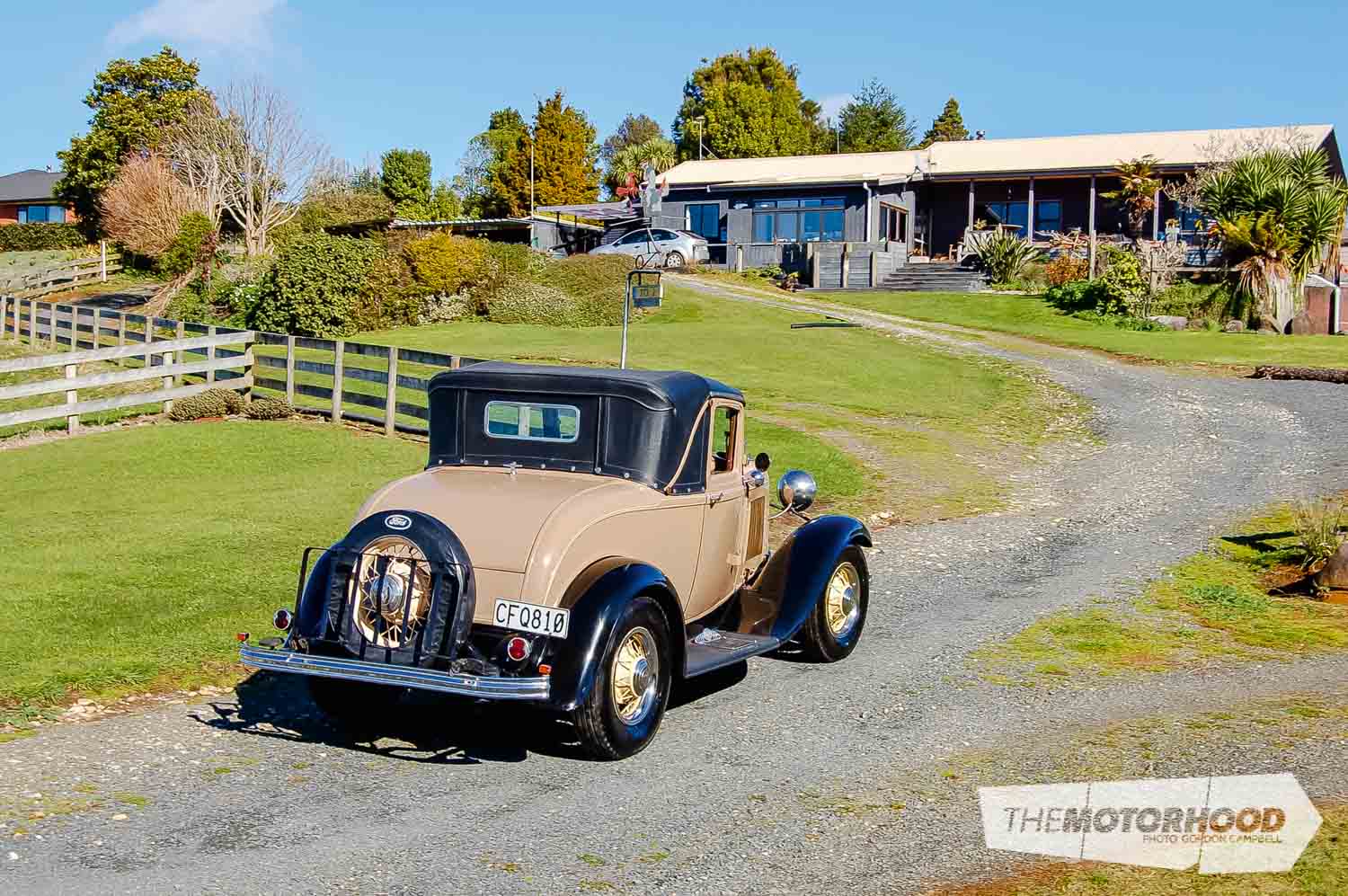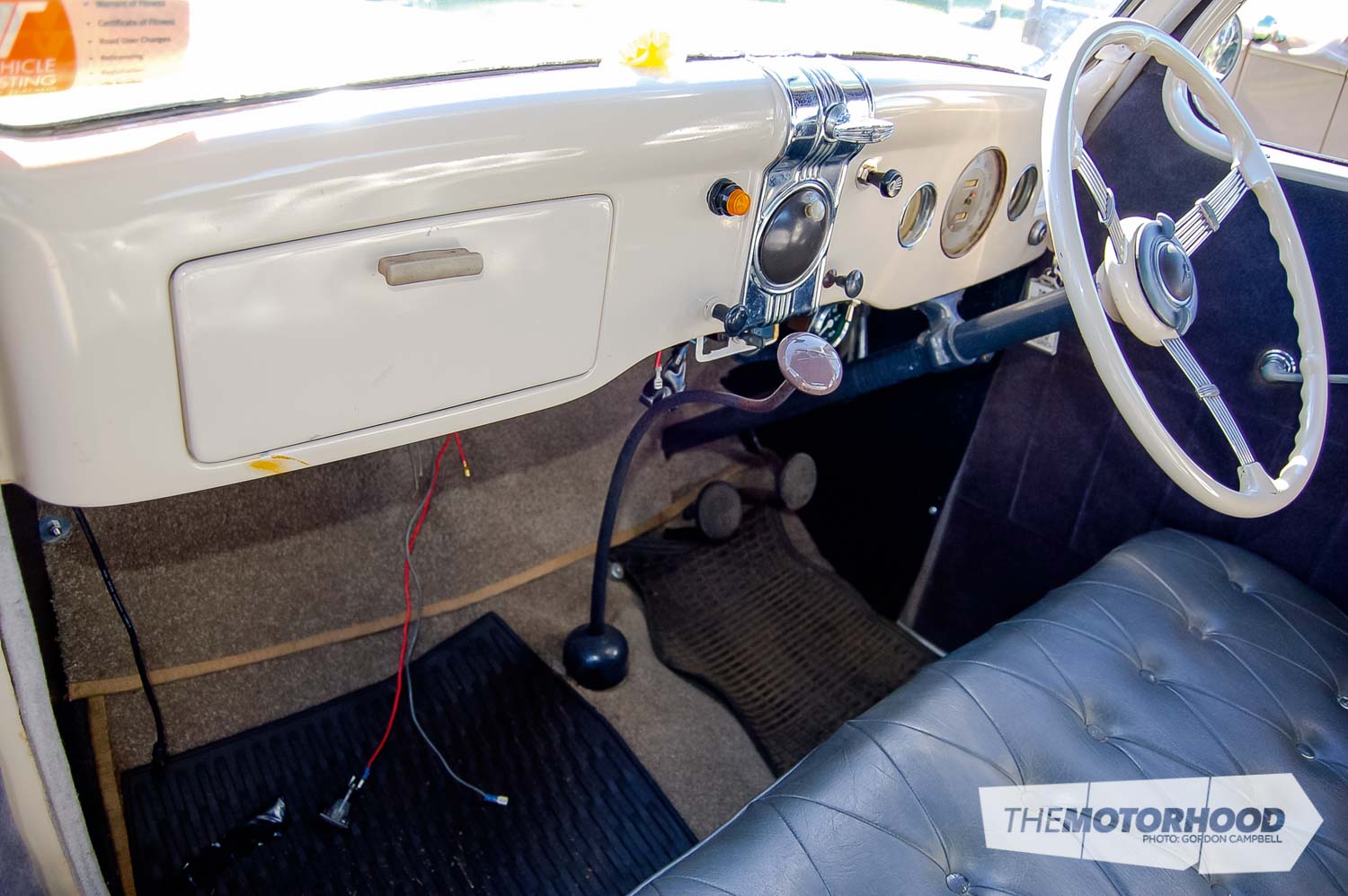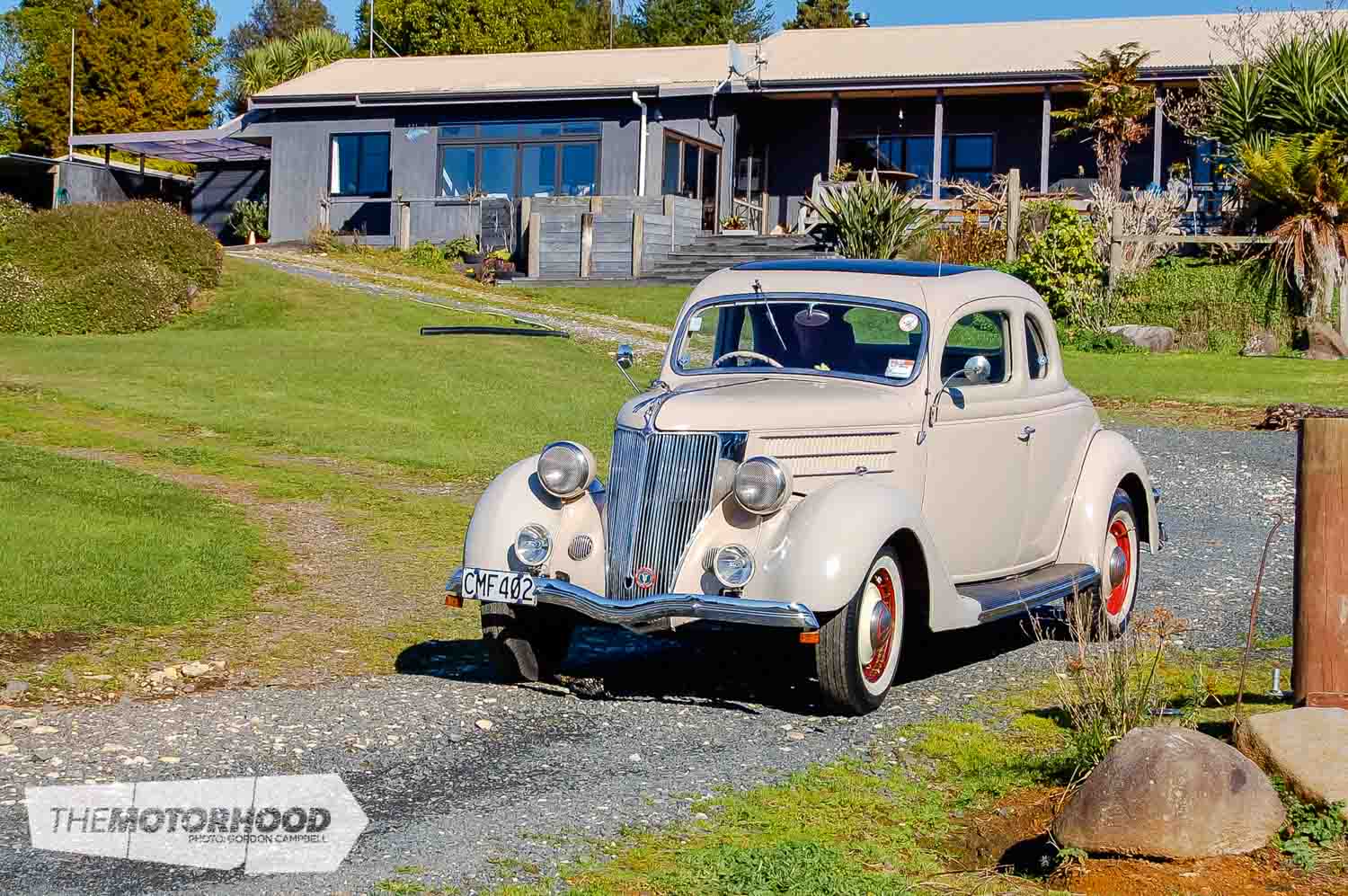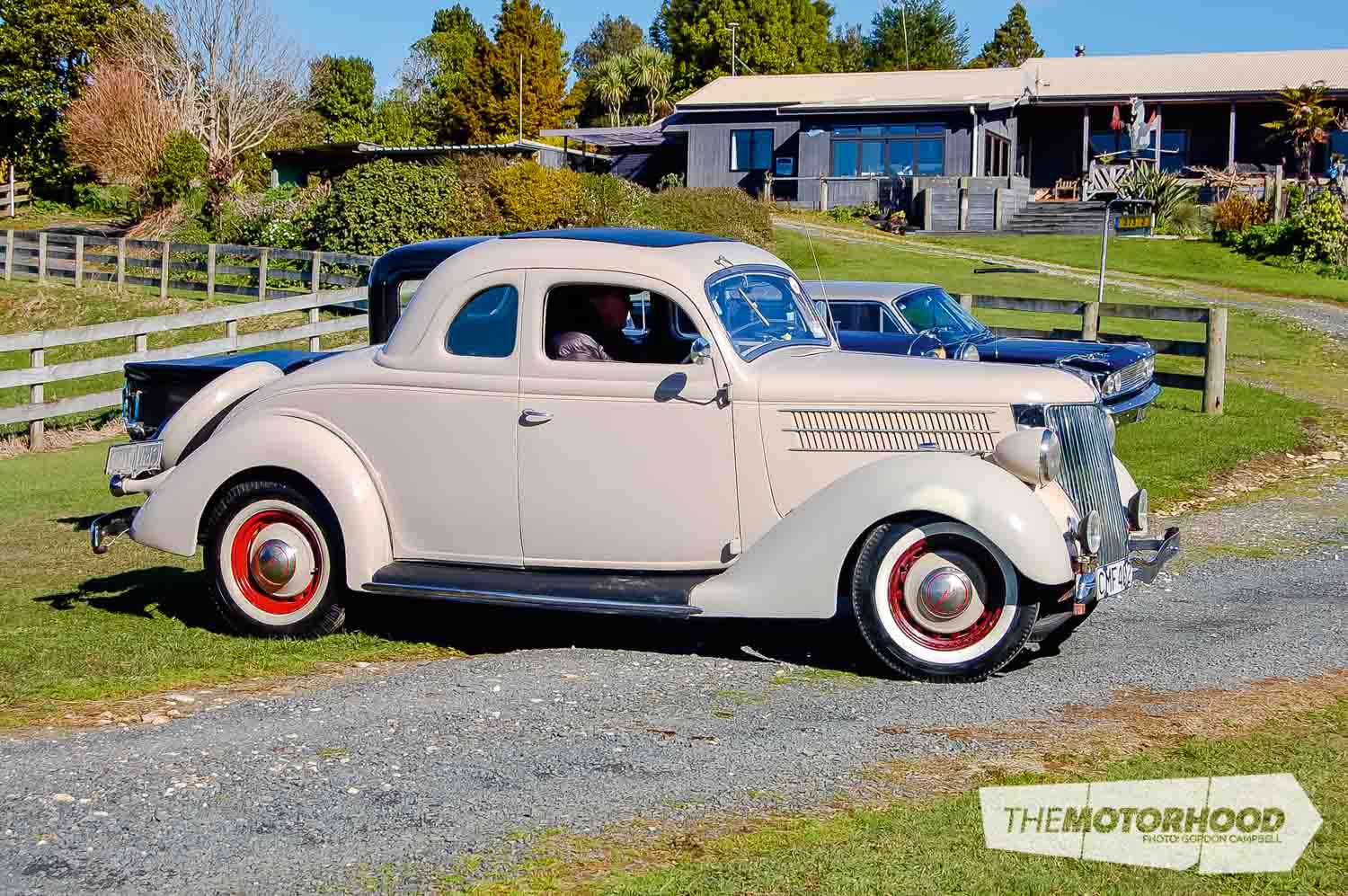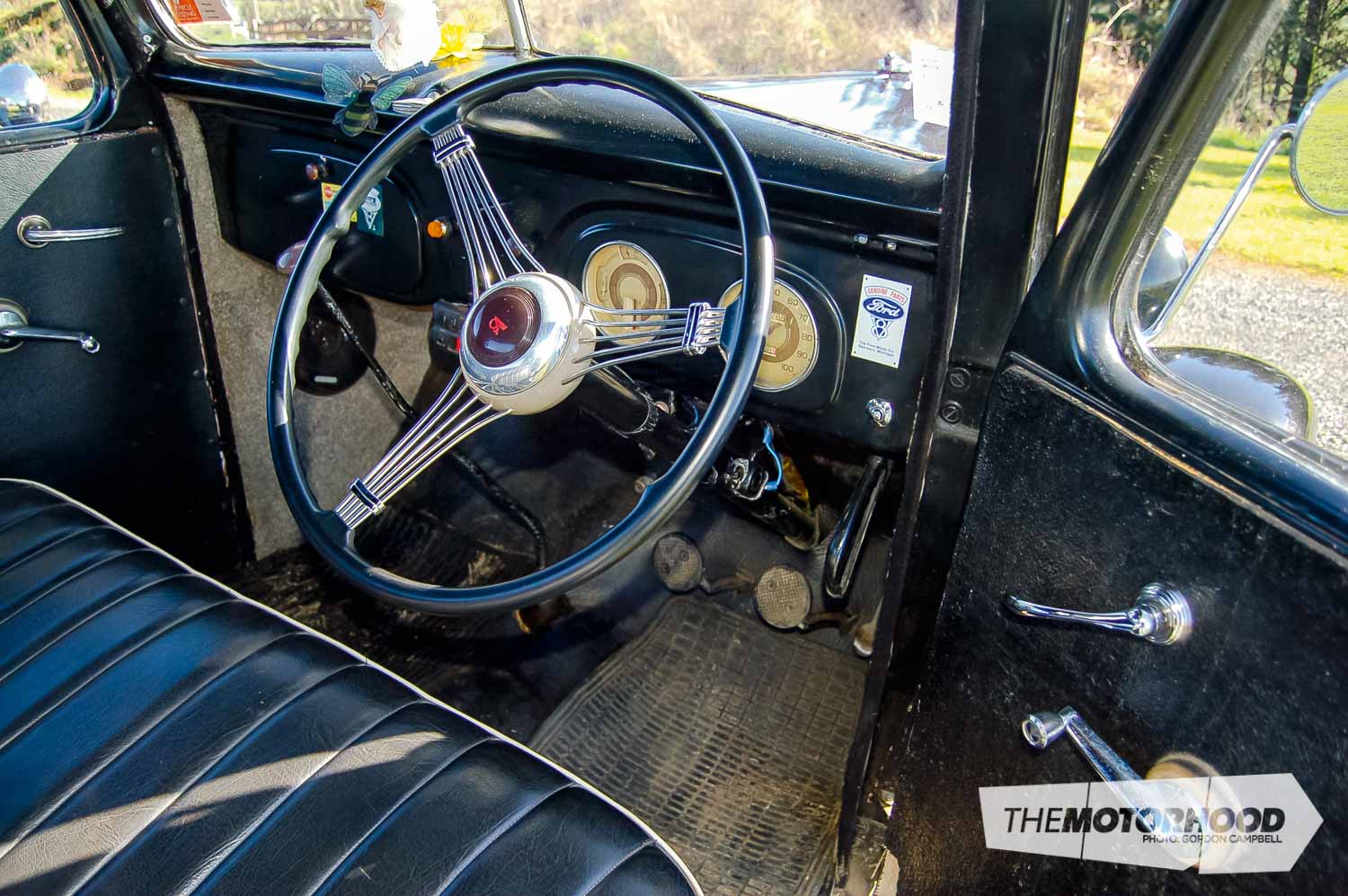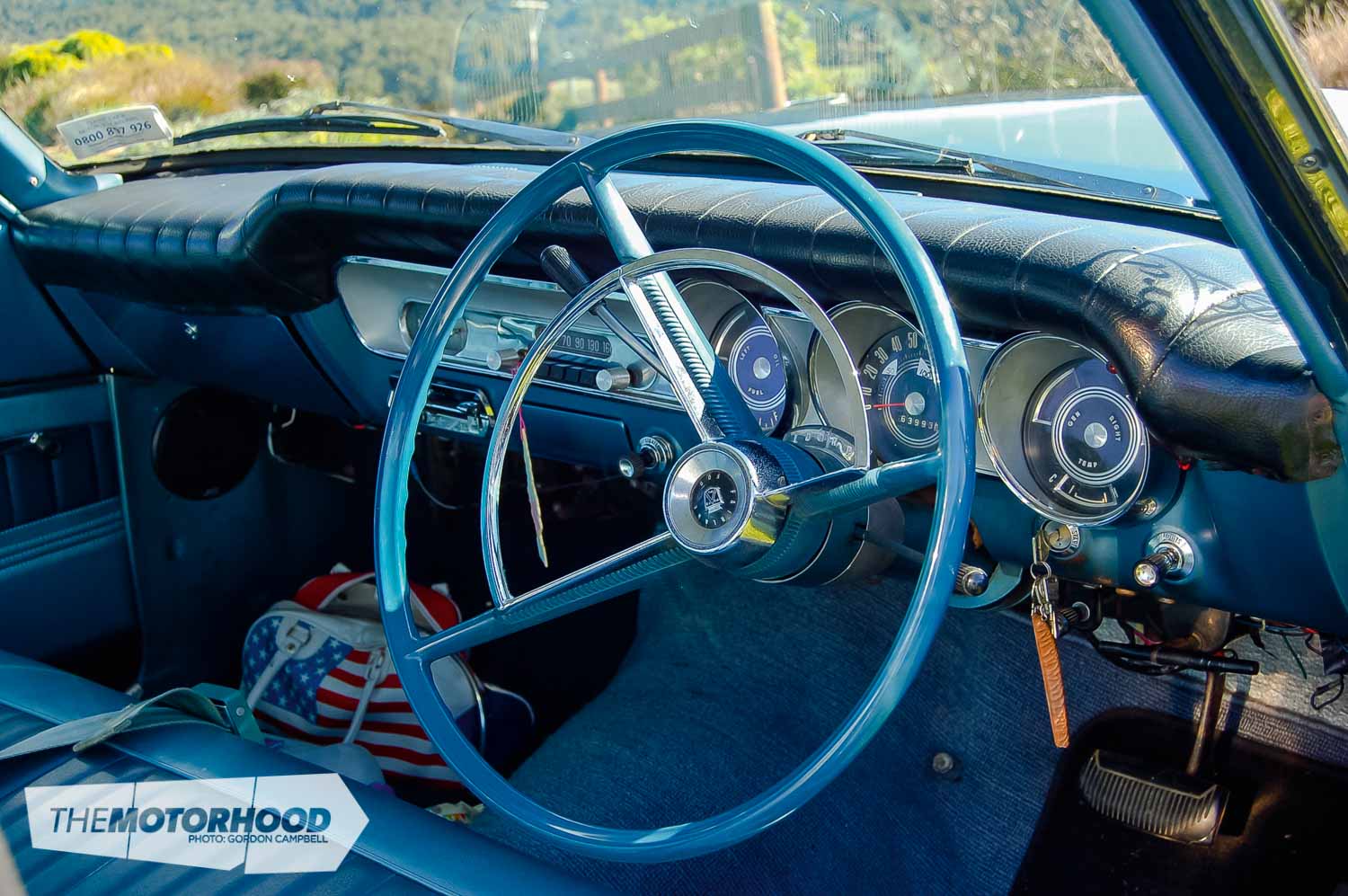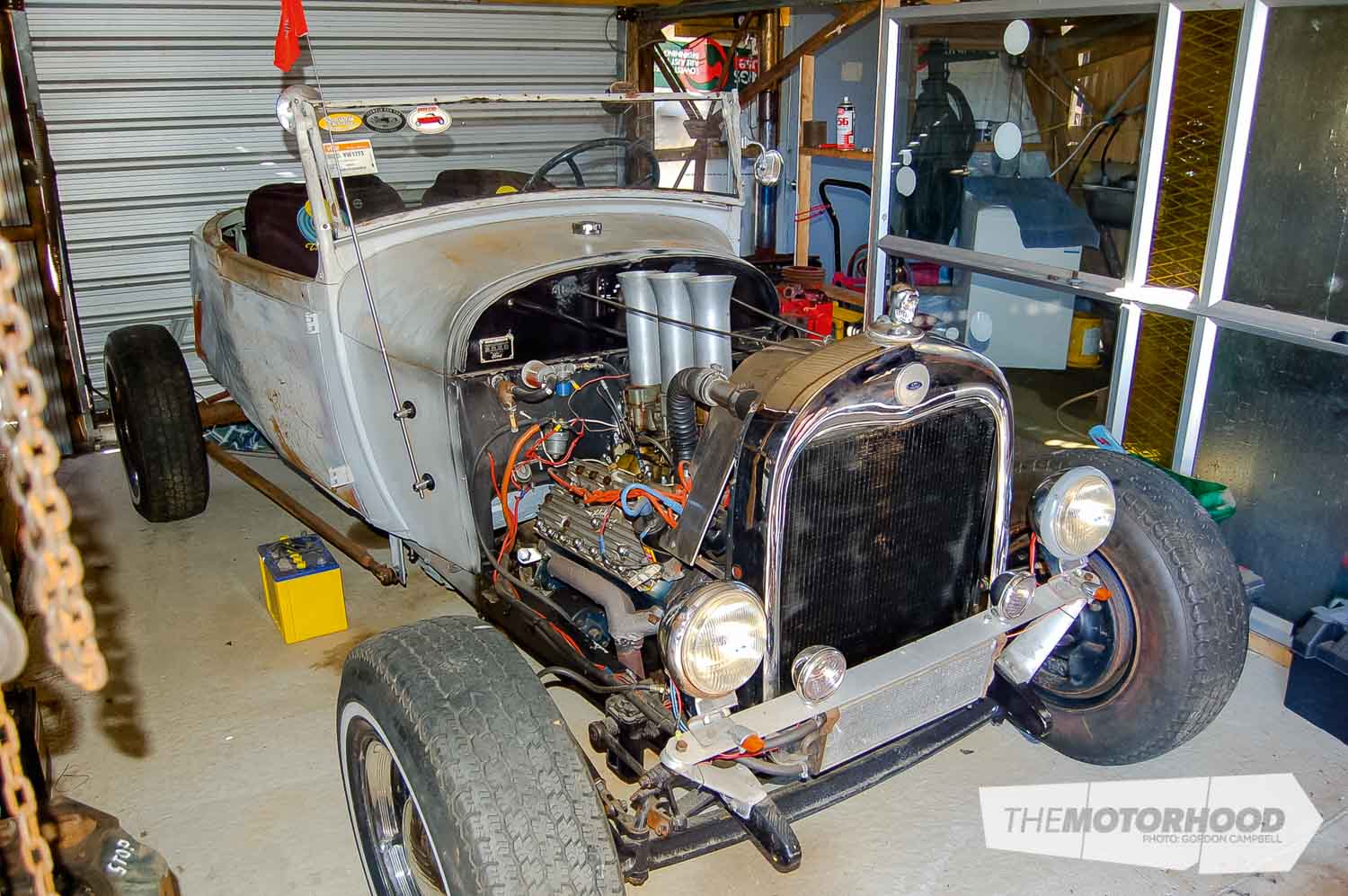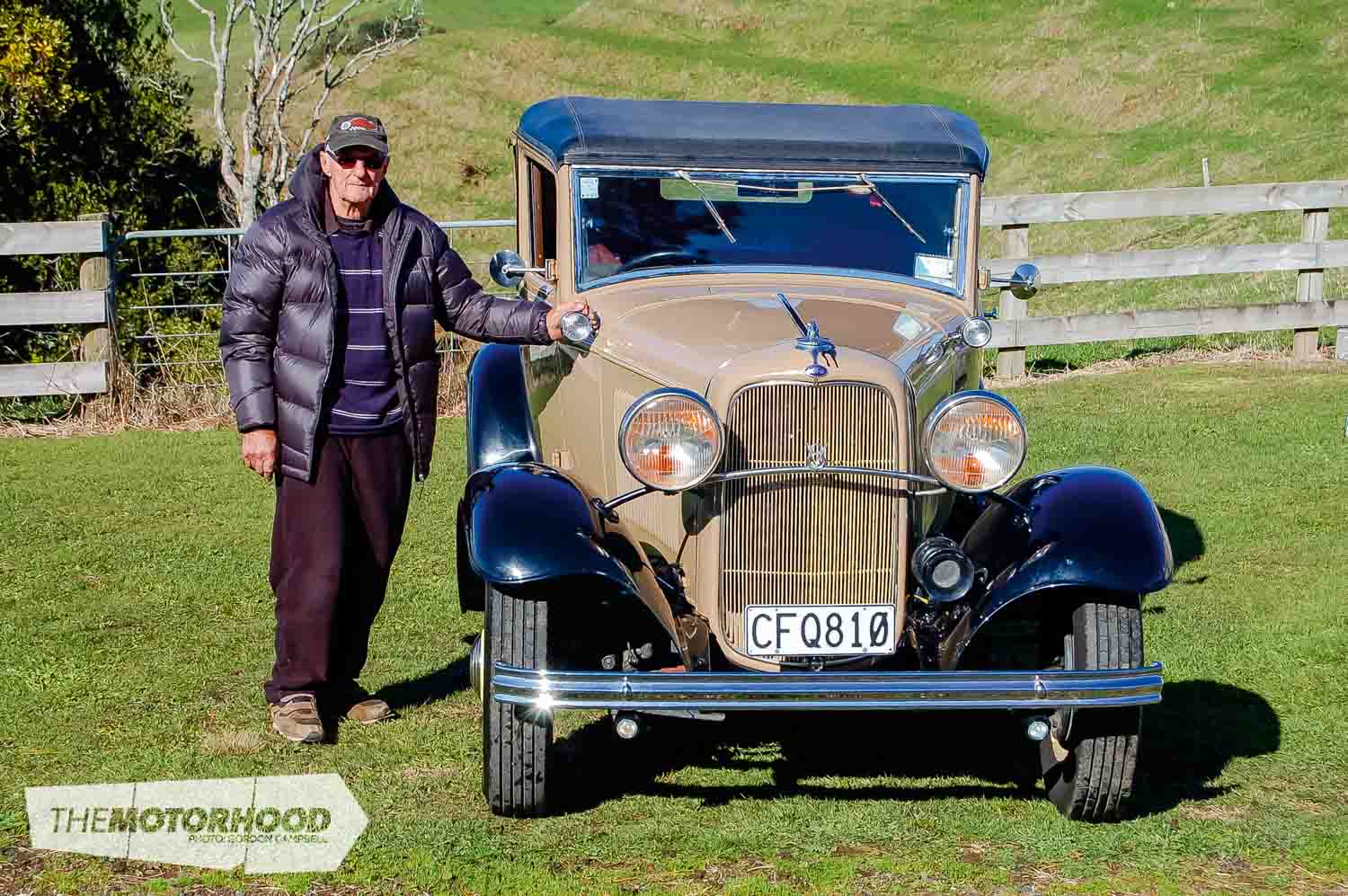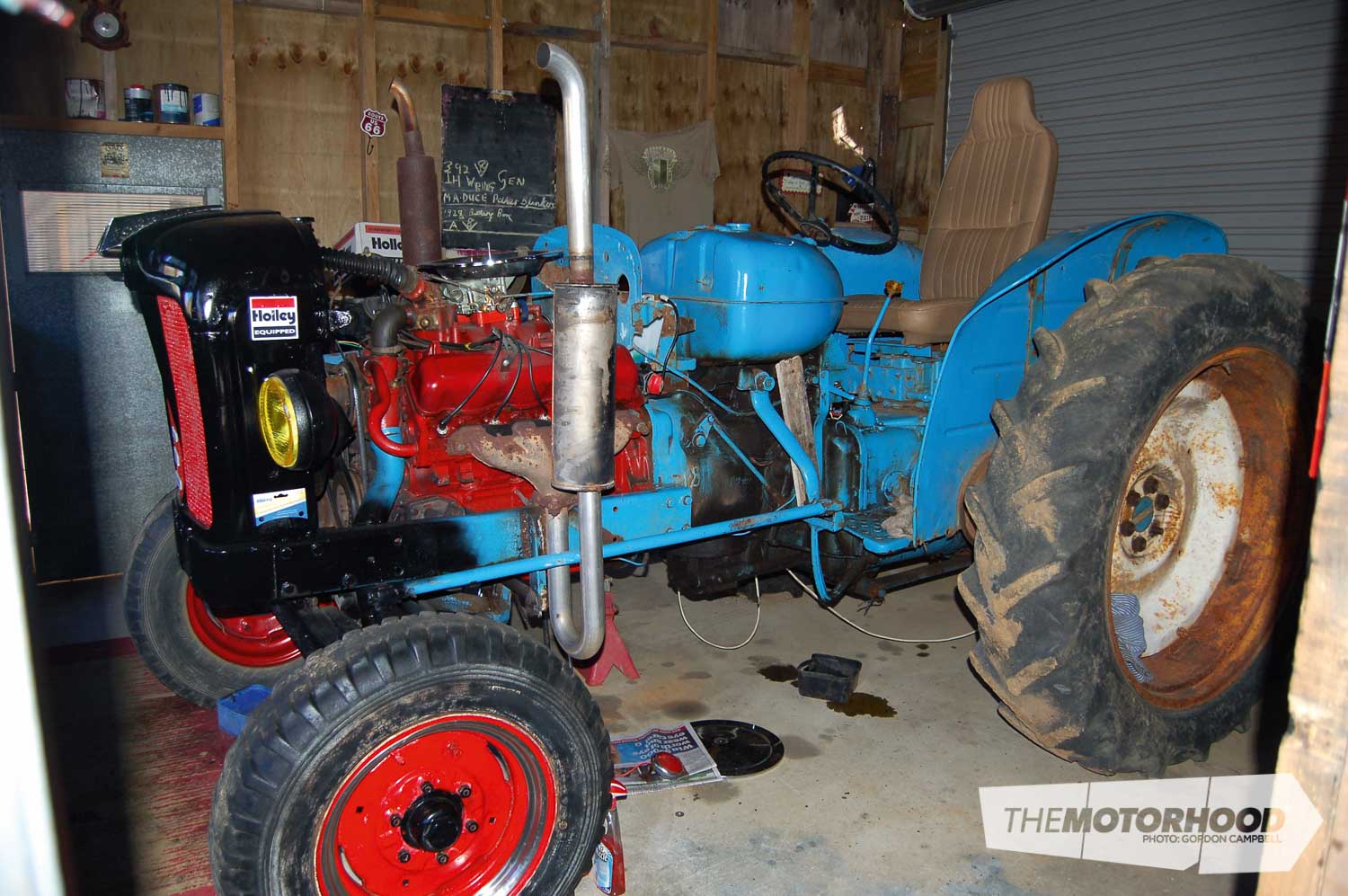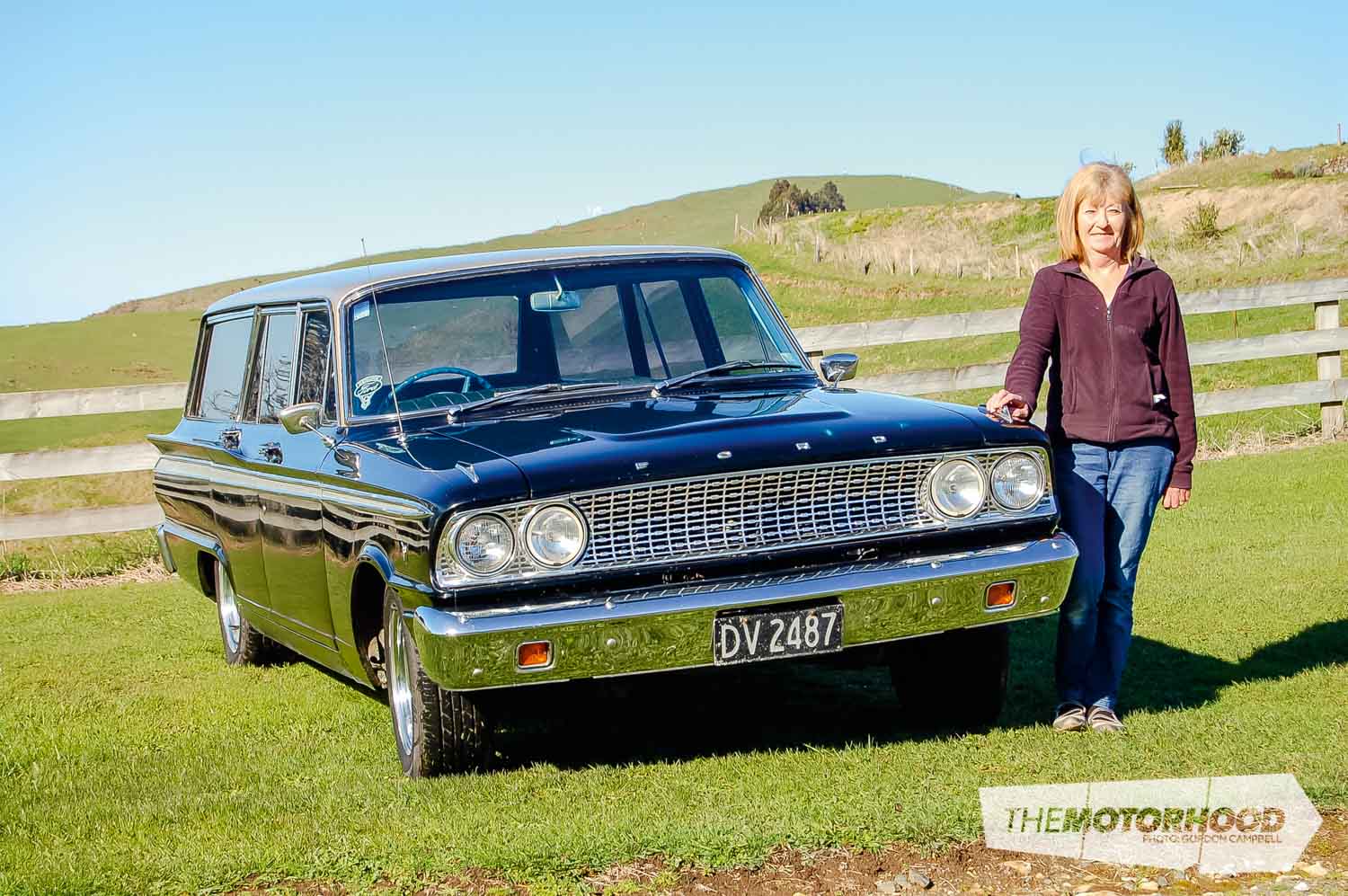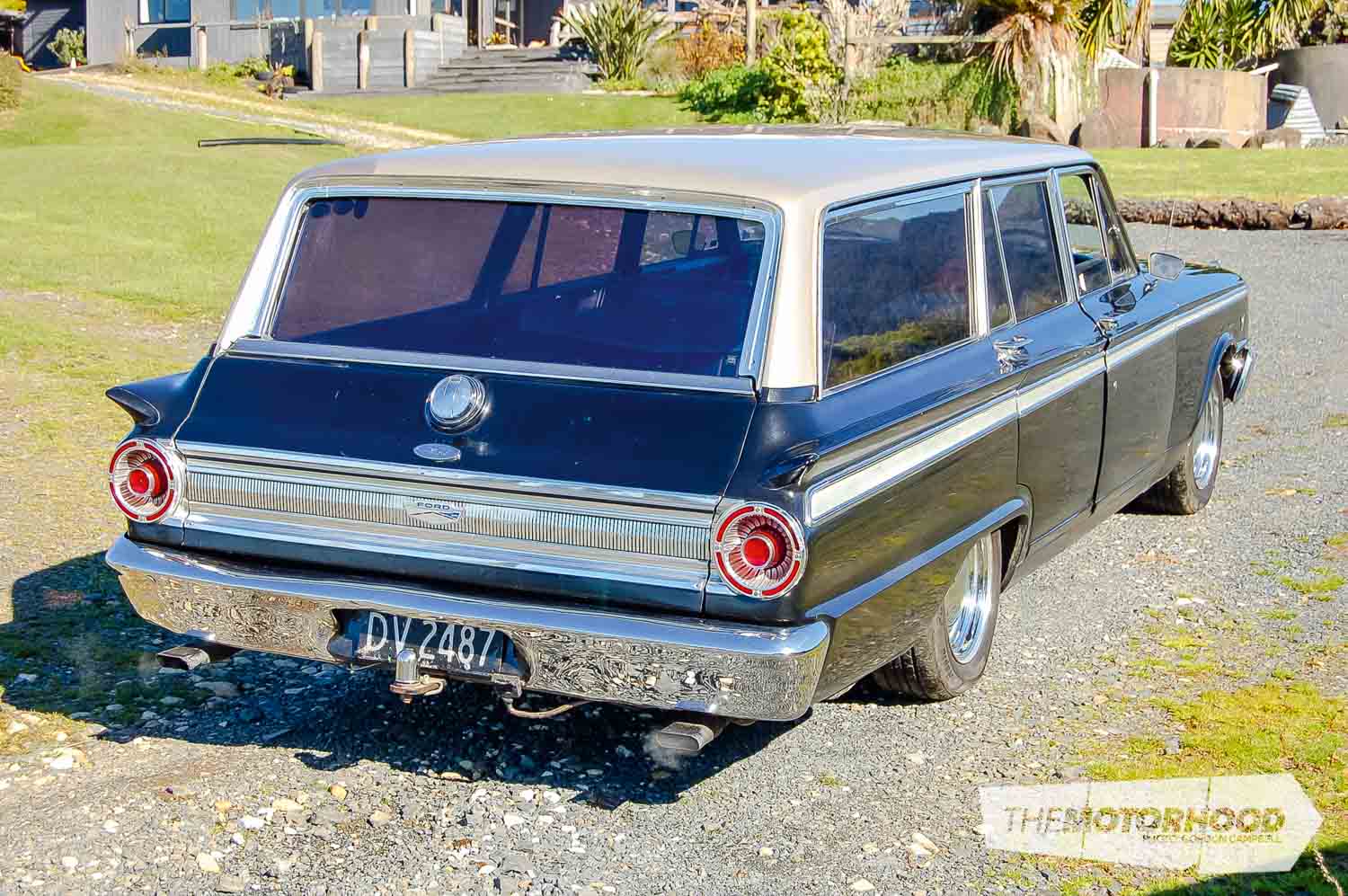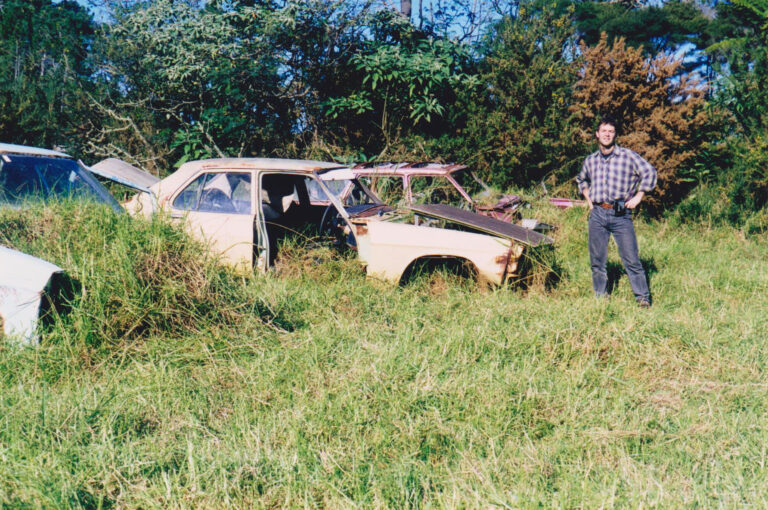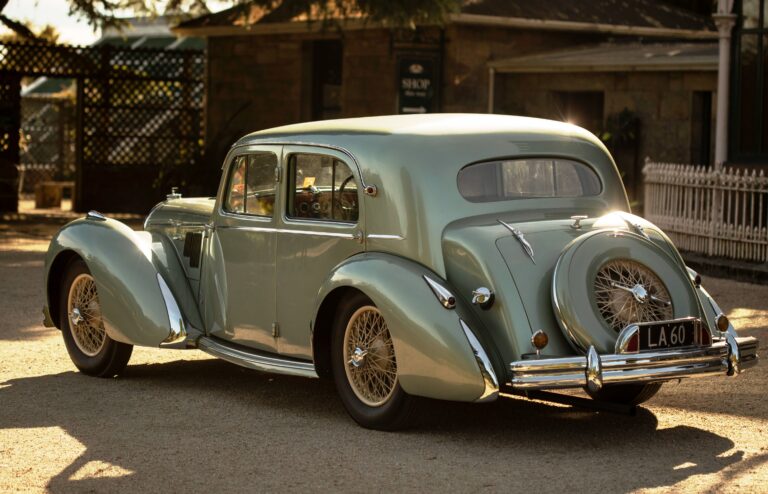Fred Boggiss is a survivor and an inspiration. He’s been through more than many people could handle, but strength of spirit, unstinting support from his wife Kathy and three lovely daughters, plus an undiminished love of cars get him out of bed every day.
Fred started a mechanic’s apprenticeship with Thompson Motors in Te Awamutu in 1958. As a Jaguar agent, back in those days it was allocated a total of two new Jaguars each year! He soon got involved in modifying cars, something he does to this day. He’s well known and respected in rodding circles.

A property high on the slopes of Mount Pirongia, with stunning views over the Waikato region, is home to Fred and Kathy and half a dozen Fords.
In about 1978, Fred bought a 1937 Ford pickup. It was a tidy work-about truck, and Fred drove it for years. Eventually he tired of its orange paint and repainted it dark and light grey. It stayed that way for some time until he decided another change was required, this time to black. It’s still in beautiful condition.
Like Fred, it’s retired from active work. A low-ratio differential means the old truck will cruise happily at the open-road speed limit.
Chevrolet rehabilitation

In 1998 Fred broke his back when he fell off a roof. His rehabilitation included buying a 1927 Chevrolet roadster restoration project. Fred completely rebuilt the Chevrolet, carrying out all the work himself, except upholstery. He chose an unusual but effective colour scheme of a cream body with maroon mudguards and running boards. Fred hadn’t intended to keep the Chevrolet and, having served its valuable purpose, it was sold to a person in Napier who wanted to join in the city’s Art Deco celebrations. The buyer was disbelieving when Fred said he would deliver the Chevrolet by driving it to Napier. Fred had no doubt the car would make it there with no problems, which it did.
Money was tight, but Fred needed a project to replace the Chevrolet. A 1936 Ford Coupe in a sad state was their next purchase. With several owners having started restoring it, it was in a million pieces, but all the parts were more-or-less present and correct. Two years of work followed. The rear mudguards were from a sedan, and Fred had to weld a 25mm-wide strip into each one to make them the right width. He does his own panel work, having learned from the company panel beater back when he was an apprentice. He also paints his vehicles, rewires them as required and has done some of the upholstery.
Ma Deuce

In October 2005 Fred and Kathy bought a 1932 Ford two-door saloon, a model that has American running gear and a British Briggs body. The most noticeable difference is its ‘suicide’ doors, which open backwards rather than forwards like the American versions. The English cars used the same body from 1932 to 1935.
As far as Fred knows, theirs is the only one in New Zealand. It’s named ‘Ma Deuce’ in memory of an inheritance from Fred’s mother, and as a nod to Ma Baker and her infamous sons.
Rightly or wrongly, the ’32 or ‘deuce’ Ford was associated with the Baker-Karpis Gang as their getaway vehicle of choice, in the era when a few criminal gangs were America’s public enemy number one, and most of them supposedly drove 1932 Fords. If it’s true, there was a good reason for their choice. The year 1932 was an important one in Ford’s history — it was the first year of the famous flathead V8 engine that powered millions of Ford vehicles over the next 22 or so years.
Real performance became available to anyone with the relatively small number of dollars asked for the new Ford. The flathead provided sparkling performance compared to the four-cylinder Chevrolets and cheaper-line Chrysler Corporation flathead sixes and fours, and was dirt cheap compared to other V8s of the time.
Flawed genius

Displacing 3621cc (221ci) from a 77.79 by 95.25mm (3.0625 by 3.75in) bore and stroke, the 1932 Ford V8 Model 18 produced just 48.5kW (65bhp). The engine was the last major design by Henry Ford and, typical of the man, it featured several design limitations and patented innovations. Crankshafts were cast steel, rather than the then usual forged, and were significantly cheaper to produce. It was the first mass-produced V8 to have a one-piece block, and its high-pressure lubrication system was fairly unusual at the time. From 1936 the Ford V8 had shell bearings, unlike most of its contemporaries. The exhaust ports were located on the inner side of each part of the engine valley and passed between the cylinders, so they severely limited space for the ports and their shape, and contributed to overheating problems. It also made overboring the cylinders a very tricky business, although Ma Deuce’s engine has been bored out to the early Mercury displacement.

Despite these shortcomings, the flathead Ford V8 is still loved all over the world, and justifiably so. It can be a thing of beauty to the visual and aural senses, especially with a few enhancements like finned cylinder heads and two or more carburettors. Not many engines sound sweeter than a well-tuned ‘flattie’. It can also be breathed on to produce serious power, as a perusal of Bonneville records shows. A Kiwi-built flathead Ford-powered racer holds the XF/BFR class record, at 295.450kph (183.584mph), which it set some years ago. Maybe there’s something in the Waikato water, as that car was built not far from Fred’s home.
Still learning

Fred’s always been a flathead V8 fan, and probably knows as much about them as anybody. He certainly knows how to modify them and make them run beautifully. There are several flatheads, from donors to fully rebuilt, safely stored in the Boggiss’ sheds, not counting those in their cars. As proof that you’re never too old to learn something new, Fred discovered just a couple of years ago why Ford flatheads have a deserved reputation for overheating. He first became aware of this problem in his father’s Jailbar logging truck, when he noticed through a hole in the floorboards that the back of the engine was glowing red hot. He pointed this out to his father, who simply looked at the temperature gauge and suggested that Fred should sit back and keep quiet.
As an adult, Fred blamed the exhaust system for the overheating, until a book on Ford flatheads gave him the answer. It was simple — there is no water jacketing around the two rear exhaust valves. Flatheads run hotter than overhead valve engines anyway, and Ford’s design made the situation worse. A proper solution would require major re-engineering, so Fred continues to use the long-standing method of a larger radiator, and making sure the water pump is in prime condition.

Another rare 1932 Ford model is the Sport Coupe, and Fred and Kathy have one. There is at least one other that they know of in New Zealand, but it’s been hot rodded. They bought theirs in December 2006, in its current condition. Fred had gone with a friend to look at a Ford Mustang which a car dealer was selling from his private collection. Out of the corner of his eye he noticed a car under a cover and, knowing it wasn’t a Model A Ford, he asked what it was.
“A ’32 Ford Sport Coupe.”
“Pardon?”
“A ’32 Ford Sport Coupe.”
Kathy says a very excited Fred arrived back home. He had to have the Sport Coupe. When Fred returned to buy it, the price had gone up, but he bought it anyway. It’s an Australian Sport Coupe rather than an American one, identifiable by the higher false hood with its steeper rear section. It was imported from Australia in 2004.

The year 2008 was a busy one for Fred and Kathy. They toured the South Island in the Sport Coupe; a trip planned around the Ford V8 Nationals in Ashburton. In more than 5000km, the only mechanical problem occurred when they were stranded in Balclutha because the locating pin fell out of the water pump pulley. A local builder gave then a 100mm nail to use as a temporary repair, until they could get the proper pin in Christchurch. They also made the pilgrimage to Bonneville that year, the American altar of speed inextricably linked to the history of the flathead Ford V8.
Traditional rod

Soon after that trip Fred found an all-steel Model A Ford Roadster body, which is now well on its way to becoming a traditional hot rod in the original, true sense of the term. Fred has built it as though it’s been stripped of any unnecessary items, as hot rodders did back in the 1940s and ’50s. Mudguards, bumpers, bonnet and any luxuries have been dispensed with, following the Colin Chapman principle of adding lightness, even though US rodders were doing it years before Chapman’s succinct phrase. Modern techno-rods are very impressive but, for me, there’s no substitute for the trad Ford roadster or coupé hot rod, invented in America after World War II — with no frills or comforts, narrow wheels and tyres and an old-school modified engine.
True to the genre, Fred has installed a hotted-up later-model engine in his Model A, in this case a 1953 model, the last year of the Ford flathead. Back in the ’50s only a fortunate few could afford to drop the much-desired Chrysler Hemi engine into a rod, or find the money for an exotic overhead-valve conversion from Ardun and a few others, so most enthusiasts took the same route to more power and speed as Fred has done. The V8 in his car sports lovely finned Edelbrock cylinder heads and triple carburettors, backed up by a Ford C4 automatic transmission. This is at least the third traditional hot rod Fred has built over the years. Old habits die hard.
In 2009, he went to hospital to have a straightforward operation to correct a serious nerve problem. The operation was a success, and Fred returned home. Very soon afterwards he suffered a brain bleed and again looked Death square in the face. The story of getting Fred to hospital on Christmas Eve, involving a flat tyre on the ambulance and other mishaps, would be hilarious if the circumstances hadn’t been so grave.
Nearly five years on, Fred has had to learn to talk again, and is mobile with the help of a nifty electric three-wheeled scooter. This allows him to get out to the sheds, to maintain his cars and work on projects. He’s found innovative ways to work around his disability.
Lethal weapon

For something completely different but still Ford related, Fred installed a 6424cc (392ci) International V8 engine in a Fordson Major tractor. Friends wondered why, but Fred likes a challenge, and he had the tractor and engine lying around. On the first test drive he let the clutch out and the Fordson reared up on its back wheels. Fred dived for his life, leaving the beast to its own devices. Fortunately the only damage was a crushed walking frame.
He found that using the low ratios made it more manageable, but the tractor remains parked in the shed for now.
Sticking with the blue oval badge, but moving forward three decades brings us to the Boggiss’ newest classic car, and their latest purchase.

In 2013, the family attended the Beach Hop at Whangamata, as they have done every year, where Kathy found a 1963 Fairlane station wagon for sale. She’s been an admirer of the compact Fairlane’s lines since they were new, and the rarity of the wagon added an extra dimension to the car’s appeal, as far as she was concerned. A deal was done at the Hop, and the car was handed over shortly afterwards.
Kathy originally intended to use the Fairlane as her daily driver, and she admits that in some ways she prefers it to their modern Ford Focus. The interior has been completely redone since she bought it, to finish off a very smart-looking car. The upholstery job included squabs for the third seat that folds out of the load area floor, an ideal place for transporting their grandchildren in car displays. This seat will be in use as soon as a full set of seat belts has been installed.
The Fairlane is not quite standard, and Kathy didn’t go into detail. It has a lightly modified small-block Ford V8 engine, an automatic transmission and power-assisted disc front brakes, to make it a car that goes and stops very well. Like their other vehicles, the Fairlane is a good-looking, distinctive car that attracts a lot of attention.
A Ford for every occasion

All of the Boggiss’ vehicles are road legal, except the hot rod — which will be in time — and all get used, even though their condition suggests otherwise. It’s pretty well impossible to pick out a car that’s more desirable than the others. Each is different, with its own special appeal. One thing most of them have in common is that their rarity is largely a result of their originality. Fred prefers to keep his vehicles original, except they have all been converted to 12-volt electrical systems, and the 1936 Coupe has hydraulic brakes. The others still have their mechanical brakes, and are proof that they can be effective when they’re set up properly.
Obviously the hot rod and the wagon aren’t original, but it’s most unusual to find 1930s Fords that are more or less as they left the factory. Which one you picked would depend on your mood at the time. For Fred and Kathy, that’s not a problem — they have a Ford for every occasion.

